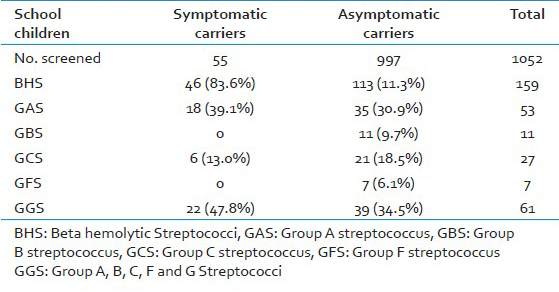Translate this page into:
A Community-Based Study of the Rate of Beta-Hemolytic Group a Streptococcal Infections in Symptomatic and Asymptomatic School Children
Address for correspondence: James John, Ph.D E-mail: james_cmc2002@yahoo.co.in
This is an open-access article distributed under the terms of the Creative Commons Attribution-Noncommercial-Share Alike 3.0 Unported, which permits unrestricted use, distribution, and reproduction in any medium, provided the original work is properly cited.
This article was originally published by Medknow Publications & Media Pvt Ltd and was migrated to Scientific Scholar after the change of Publisher.
Sir,
Group A streptococcus (GAS), Streptococcus pyogenes, is a human pathogen that known to cause a wide spectrum of infections. Disease spectrum ranges from relatively benign infections to severe invasive diseases leading to serious post streptococcus sequalae, like acute rheumatic fever and acute glomerulonephritis and rheumatic fever (RF), rheumatic heart disease (RHD).[1] GAS are the most frequently isolated pathogens in acute pharyngotonsilitis in school-aged children,[2] and streptococcal pharyngitis is one of the most common childhood bacterial infections.
A surveillance study of beta-hemolytic streptococci (BHS), infections was conducted in school children aged 5-15 years from two different government public schools in Arasur village, located near the city of Gulbarga in Karnataka, South India. The approximate distance between Gulbarga and Arasur village is approximately 30 km. Arasur village has poor hygienic conditions and a lack of basic treatment facilities situated in a typical agricultural farmland represent spring climate condition with temperature varying 22-27°C around the year. A total of 1052 children were randomly selected, including 997 asymptomatic children (normal) and 55 with symptoms of pharyngitis (symptomatic) during entire study period from August 2009 to January 2010. The study was designed and approved by ethical committee (institutional review board) of our institution. Throat swabs and blood samples (~3 mL) were collected from each child who presented with clinical signs or symptoms of sore throat, fever, chills, malaise, erythema, and swelling of the pharyngeal mucosa were included. Samples were also collected from asymptomatic (normal) children who were followed for couple of weeks to look into any possibility of developing pharyngitis.
Isolates were confirmed by the Streptococcus Laboratory, Department of Clinical Microbiology, Christian Medical College, Vellore, Tamil Nadu, using standardized methods.[3]
Anti-streptolysin O (ASO) antibodies were detected by commercial test kits according to manufacturer's instructions (Tulip Diagnostics, Goa, India). Among the asymptomatic children, BHS were isolated from 113 (11.3%) of the 997 children screened. Of these isolated BHS, 35 (30.9%) belonged to group A, 11 (9.7%) to group B, 7 (6.1%) to group F, 21 (18.5%) to group C, and 39 (34.5%) to group G. A total of 46 BHS were isolates from 55 symptomatic children. Of these BHS, 18 (39.1%) belonged to group A, 6 (13%) to group C, and 22 (47.8%) to group G [Table 1a]. None of the BHS isolated from symptomatic school children belonged to group B or group F. Therefore, in this study, the overall incidence rates of GAS, group C streptococci (GCS), and group G streptococci (GGS) infection among symptomatic and asymptomatic children were found to be 5%, 2.5%, and 5.7%, respectively [Table 1b]. Eight (17.3%) of the 46 symptomatic children were ASO positive; (with titers of 200 IU/mL and 2 with titers of 400 IU/mL) and all eight children were also positive for GAS. Of the 113 asymptomatic children, four (3.5%) were positive for ASO. Their titers were 200 IU/mL (n = 2), 600 IU/mL, and 800 IU/mL. All four children were also positive for GAS. None of the children with non-GAS demonstrated ASO positivity. Insufficient hygienic facilities and lack of other basic amenities at schools and children from lower socioeconomic classes might be the reason for high GAS carriage in current study. GGS/GCS are generally considered to be commensals; however, due to horizontal transfer of genetic material with GAS (Davies et al., 2005)[4] GGS and GCS share many virulence factors same tissue niche in humans, and cause a similar spectrum of diseases.


In the final analysis, a laboratory diagnosis of GAS pharyngitis can only be made by recovering the organism in high numbers (>100 colonies on sheep blood agar) in the presence of clinical signs and symptoms. However in endemic regions, this may also be due to a viral infection with heavy GAS colonization. If ASO testing is carried out in such cases, it can act as a useful diagnostic adjunct for accurately confirming the cause of the infection.[5] We conclude that regular surveillance of BHS throat infections in rural school children may be helpful in designing effective preventive strategies for poststreptococcal sequelae.
REFERENCES
- Group A streptococcal infections in children. J Paediatr Child Health. 2007;43:203-13.
- [Google Scholar]
- Throat and Nose. In: 13. Kang HP, Dunne WM, eds. Stability of Repetitive. Sequence PCR Myerfs and Koshi's manual of Diagnostic Procedures in Medical Microbiology and Immunology/ Serology. Faculty, Department of Clinical Microbiology, Christian Medical College, Vellore, India. Pondicherry: All India Press; 2001. p. :52-6.
- [Google Scholar]
- Laboratory diagnosis of group A streptococcal infections. Geneva: World Health organization; 1996.
- [Google Scholar]
- Inter-species genetic movement may blur the epidemiology of streptococcal diseases in endemic regions. Microbes Infect. 2005;7:1128-38.
- [Google Scholar]
- Group A streptococcal infections of the pharynx in a rural population in south India. Indian J Med Res. 2004;119:171-3.
- [Google Scholar]




